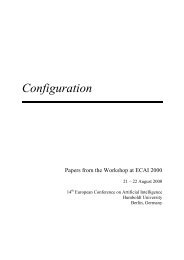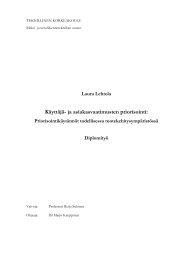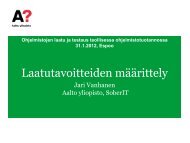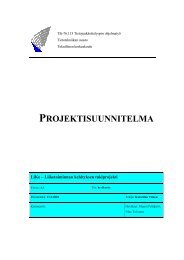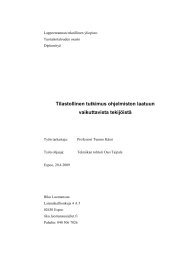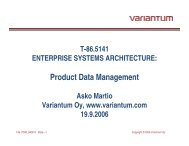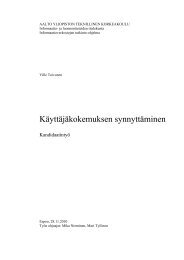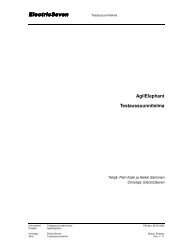An Introduction to BPEL standard and its extentions - SoberIT
An Introduction to BPEL standard and its extentions - SoberIT
An Introduction to BPEL standard and its extentions - SoberIT
Create successful ePaper yourself
Turn your PDF publications into a flip-book with our unique Google optimized e-Paper software.
3.3.1.1 Human rolesIn <strong>BPEL</strong>4People process, four generic human roles are defined: process initia<strong>to</strong>r, process stakeholders,potential owner <strong>and</strong> business administra<strong>to</strong>rs [13, 15].Process initia<strong>to</strong>r is the person who triggers the process instance. The initia<strong>to</strong>r can be either determined bythe process au<strong>to</strong>matically or specially assigned.Process stakeholder is the person who can influence the progress of a process instance. Their responsiblecan be adding attachment, forward task or follow the process progress. If no process stakeholders arespecified, the process initia<strong>to</strong>r becomes the process stakeholder. The process stakeholder is onlyassociated with a process instance.Potential owner is the person who is assigned <strong>to</strong> claim <strong>and</strong> complete the activity.Business administra<strong>to</strong>r is the person who is allowed <strong>to</strong> perform administrative actions on the businessprocess. If no business administra<strong>to</strong>rs are specified, the process stakeholders become the businessadministra<strong>to</strong>rs. Unlike process stakeholder, a business administra<strong>to</strong>r has an interest in all processinstances <strong>and</strong> not just one.3.3.1.2 People linkPeople links are used <strong>to</strong> bind a group of people <strong>to</strong> a business process, they are similar <strong>to</strong> partner linkswhich are used <strong>to</strong> bind Web services <strong>to</strong> processes. People links are usually associated with generic humanroles.Using human roles <strong>and</strong> people link, a people activity is defined (Section 3.3.2.1).3.3.2 ScenariosPeople interaction can be as simple as manual approval, such as giving approval/rejection <strong>to</strong> loan request.People interaction can be more complex involving data, such as feeding cus<strong>to</strong>mer feedback <strong>to</strong> the process.The scope of <strong>BPEL</strong>4People is described in five scenarios [15].3.3.2.1 People activityThe new <strong>BPEL</strong> activity – people activity is not performed by any software, it is the task assigned <strong>to</strong> a user<strong>and</strong> it requires action be performed by that user [15]. The ac<strong>to</strong>r of a people activity is determined by apeople link. In PBEL4People, <strong>BPEL</strong> engine does not invoke Web services, instead it creates <strong>and</strong>distribute a task <strong>to</strong> certain user. <strong>An</strong>d user needs <strong>to</strong> carry out specific action on task. Like <strong>BPEL</strong> activity,people activity has name <strong>and</strong> input/output variable, it allows the specification of deadlines. Moreover,people activity can set a priority, which prioritizes the work people work on [15].3.3.2.2 Initiating processWhen a group of people involved in a business process, it is necessary <strong>to</strong> appoint people who initiate abusiness process.



